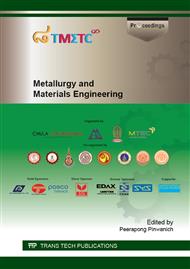p.53
p.59
p.64
p.69
p.76
p.81
p.86
p.91
p.96
Effects of Destabilisation Heat Treatment on Microstructure, Hardness and Corrosion Behaviour of 18wt.%Cr and 25wt.%Cr Cast Irons
Abstract:
Effects of destabilisation heat treatment on microstructure, hardness and corrosion resistance of 18wt.%Cr and 25wt.%Cr irons have been investigated. The as-cast samples were heat-treated by destabilisation at 1000°C for 4 hour and then air cooling. The microstructure was investigated by light microscopy and scanning electron microscopy. The results show that the as-cast microstructure in 18wt.%Cr iron consists of pearlite, formed by decomposition of primary dendritic austenite, plus eutectic structure. In the 25wt.%Cr iron with lower hardness, the microstructure consists of primary dendritic austenite plus eutectic structure. The austenite had partly transformed to martensite, especially at areas adjacent to eutectic carbides. After destabilisation, the microstructure of both irons consists of eutectic and secondary carbides in a martensite matrix giving increased hardness. It was found that corrosion resistance of the irons was improved after destabilisation. The 25wt.%Cr showed superior corrosion resistance than the 18wt.%Cr iron due to greater residual Cr in the matrix to encourage passivity.
Info:
Periodical:
Pages:
76-80
Citation:
Online since:
July 2015
Authors:
Price:
Сopyright:
© 2015 Trans Tech Publications Ltd. All Rights Reserved
Share:
Citation:


